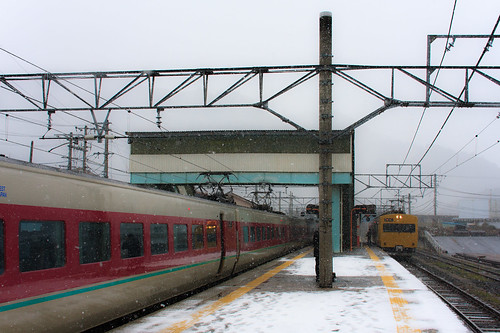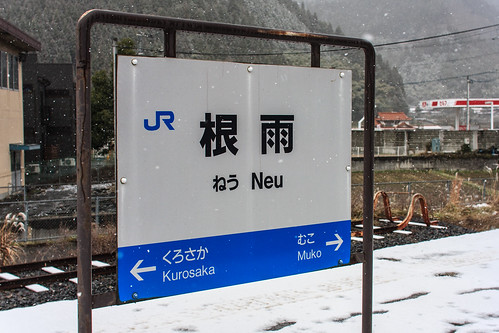JR West Hakubi Line - JR西日本伯備線
 |
| Looking towards Yonago at Neu Station |
Location Name: JR West Hakubi Line - JR西日本伯備線
Type: Railway Line 列車線
Location: Tottori and Okayama Prefectures, Chukoku Region, JAPAN
Terminals: Kurashiki Station, Hoki-Daizen Station
Distance: 138.4km
Number of Stations: 28
The Hakubi Line is a major north-south train line cutting across the Chukoku region of Honshu. It begins in Kurashiki when the Hakubi Line splits from the Sanyo Main Line just after leaving the station. From Kurashiki the line follows the Takahashi River up into the mountains through mostly flat farmlands and semi-rural sprawl. The line is shared with the private Ibara Railway for its single line from Kiyone to Soja. Also at Soja the Kibi Line, a short, commuter line that serves the upper parts of the Okayama plain, ends. From Soja the line follows the river, goes through tunnels, and cuts across small agricultural valleys as it makes it was into the mountains. Mining and light industry is also visible from the line.
Only two local trains run the entire Hakubi line in one shot heading all the way to Yonago. The remainder stop at Bitchu-Takahashi or Niimi. On those trains to Niimi most of the passengers will get off by Bitchu-Takahashi. After that station the train enters even more rural areas and the line becomes primarily single track till the terminal in Tottori prefecture. Between Bitchu-Takahashi and Niimi the train passes by Ikura station which provides access to the Ikura Cave a regional tourist attraction.
Niimi is an important transportation hub for JR West. It is the middle point in a line of three major stations in the mountainous center of the Chukoku region. Miyoshi to the West and Tsuyama to the East are the other two. I have been through all three of the stations at least twice and all have been featured on this blog. The Kishin Line from Tsuyama and Himeji terminates here and trains heading west on the Geibi Line to Miyoshi and Hiroshima originate here.
 |
| Snow at Neu Station. The yellow train is a local for Yonago. |
The next station past Niimi is called Nunohara. While technically on the Hakubi line no Hakubi Line train stops at the station. The average of one person a day who uses the station must either ride one of the trains headed for the Geibi line back to Niimi or on to Bingo-Ochiai and Miyoshi. Nunohara station used to be important as a staging area when steam trains were still in service but lost importance when the rolling stock was upgraded to diesel. Moving on past Nunohara is Bitchu-Kojiro when there Geibi Line officially begins. Between Bitchu-Kojiro and Kami-Iwami the line reaches its highest point, crosses the border into Tottori and the control is changed from Okayama to Yonago. After entering Tottori the train will begin it’s decent towards the Sea of Japan. Beautiful farmland and the Hino River can be seen along the track as it crosses through this sparsely populated part of Honshu.
 |
| Neu Station |
 |
| Hino-cho |

The Hakubi Line is the workhorse of the lines connecting the San’in (Japan Sea side) to the Sanyo (Seto Inland Sea side) of Japan [陰陽連絡路線]. None of the other lines run express trains for the entire length. This means the ride is less dramatic as parts of the Inbi or Kibi lines, and there is not as much absolute wilderness along the ride. The line is still a great way to see some of the less explored parts of Japan with some great scenery along the route. It also provides access to Yonago and Matsue two of my favorite cities both with history, cuisine and abundant hot springs.
 |
| Left: Omusubi Kororin Right: Bise |
Okayama station has a large selection of Ekiben for the trip. On the way from Okayama to Izumo-shi I had the Bisei bento with beef and pork on a bed of rice. Yuko had the Omusubi Kororin a two box bento with a collection of small onigiri on the bottom and various little things on the top.
The name Hakubi (伯備) comes from Hoki Province (伯耆の国) which used to be the area around Yonago in western Tottori Prefecture and Bitchu Province (備中国) which is now western Okayama Prefecture. The names Bitchu and Hoki are used in station names along the line to differentiate them from stations with the same names in other regions.
Hakubi Line - 伯備線 at EveryTrail
Hakubi Line - 伯備線 at EveryTrail



1 comment:
Wow, the snow is falling a bit there! And I always get a bento whenever I'm on a shinkansen. :)
By the way, I have my own blog which focuses on Asian culture and entertainment such as video games and I wonder if it is possible for you to view it and tell me what you think and how to improve my blog in the “About the Writer” page please: http://nynyonlinex.wordpress.com
Post a Comment